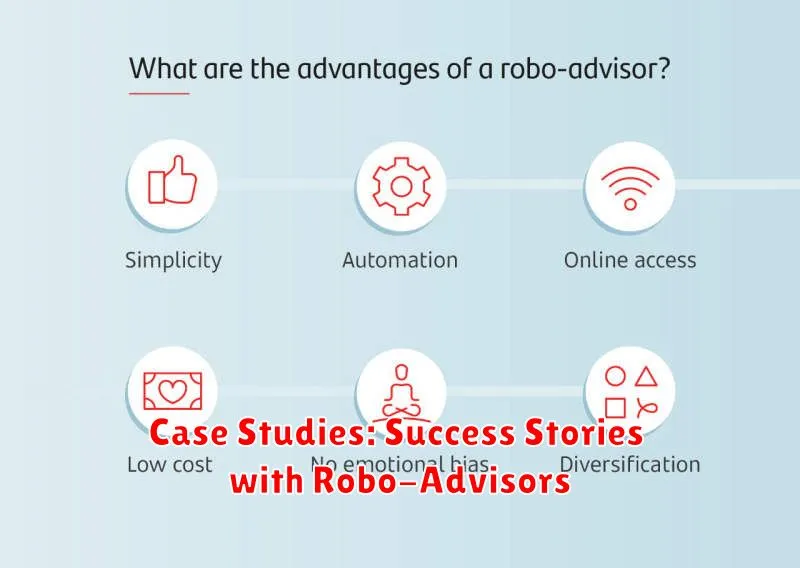In today’s fast-paced world, managing personal finances can feel overwhelming. From tracking expenses to investing for the future, the complexities of financial planning often leave individuals feeling lost and unsure. Fortunately, technology has stepped in to offer a helping hand, with robo-advisors emerging as a game-changer in the financial landscape. These automated platforms leverage sophisticated algorithms and artificial intelligence to provide personalized financial advice and manage investments, making the journey toward financial wellness more accessible and efficient.
Robo-advisors have gained immense popularity by offering a compelling alternative to traditional financial advisors. They cater to a diverse range of investors, from beginners seeking guidance to experienced individuals looking for a cost-effective solution. By eliminating the need for human intervention, robo-advisors streamline the investment process, eliminating the associated fees and reducing the time commitment required to manage finances.
What is a Robo-Advisor?
In the world of personal finance, a robo-advisor is an automated investment platform that uses algorithms and technology to create and manage investment portfolios. These platforms are designed to provide investment advice and services with minimal human intervention.
Robo-advisors typically gather information about your financial goals, risk tolerance, and investment time horizon through an online questionnaire. Based on this information, they create a diversified portfolio of low-cost exchange-traded funds (ETFs) or mutual funds that aligns with your investment objectives. They then automatically rebalance your portfolio as market conditions change, ensuring that your asset allocation stays on track.
Robo-advisors are often lauded for their transparency, affordability, and convenience. They provide access to investment management services, even for those with limited financial resources, through low fees and minimal account minimums. Their online interface allows users to track their investments and make changes to their portfolios conveniently from anywhere with internet access.
How Do Robo-Advisors Work?
Robo-advisors are digital platforms that provide automated financial advice and portfolio management services. They use algorithms and sophisticated software to analyze your financial goals, risk tolerance, and investment preferences, then recommend a personalized investment portfolio.
The process typically starts with a simple questionnaire to gather basic information about your financial situation. Based on your answers, the robo-advisor builds a portfolio tailored to your needs, often using a mix of exchange-traded funds (ETFs) or low-cost index funds.
Robo-advisors also offer ongoing portfolio monitoring and rebalancing services, automatically adjusting your investments as market conditions change. This ensures your portfolio stays aligned with your goals and risk tolerance over time.
Here’s a simplified breakdown of how robo-advisors operate:
- Data Gathering: You provide information about your financial goals, risk tolerance, and investment timeline.
- Portfolio Construction: The robo-advisor’s algorithms analyze your data and recommend an appropriate portfolio of ETFs or index funds.
- Automated Investment: The robo-advisor handles the investment process, buying and selling assets on your behalf.
- Ongoing Monitoring: The platform continuously monitors market changes and rebalances your portfolio to maintain its target allocation.
- Reporting and Communication: You receive regular reports and updates on your portfolio performance and progress toward your goals.
While robo-advisors offer automation and convenience, it’s essential to remember that they are not a replacement for professional financial advice. If you have complex financial needs or require personalized guidance, a human financial advisor may be a better fit.
Benefits of Using a Robo-Advisor for Financial Planning
Robo-advisors have emerged as a popular alternative to traditional financial advisors, offering a convenient and cost-effective approach to managing your finances. These automated platforms use algorithms and technology to create personalized investment portfolios based on your goals, risk tolerance, and financial situation. While traditional financial advisors provide valuable personalized guidance, robo-advisors offer several compelling benefits that make them an attractive option for many individuals.
One of the most significant benefits of using a robo-advisor is its affordability. Robo-advisors typically charge lower fees than traditional advisors, often charging a flat percentage of your assets under management. This makes financial planning accessible to a wider range of individuals who may not have the resources for traditional advisory services.
Another key benefit is convenience. Robo-advisors are accessible online 24/7, allowing you to manage your investments and track your progress from anywhere with an internet connection. You can easily adjust your investment strategy, deposit funds, or withdraw money through their user-friendly platforms.
Furthermore, robo-advisors employ sophisticated algorithms to create diversified portfolios that align with your investment objectives. These algorithms consider various factors like market trends, asset allocation, and risk management to ensure your portfolio is well-balanced and tailored to your individual needs. This reduces the risk associated with investing and helps maximize your returns.
Lastly, robo-advisors provide transparency and clarity in their investment strategies. You can access detailed reports and insights about your portfolio performance, allowing you to understand how your investments are performing and how they contribute to your financial goals. This level of transparency builds trust and empowers you to make informed decisions about your finances.
Robo-Advisors vs. Traditional Financial Advisors
The rise of robo-advisors has shaken up the financial planning landscape, offering a more accessible and affordable alternative to traditional financial advisors. While both options offer valuable services, they cater to different needs and financial situations. Understanding the key differences between robo-advisors and traditional financial advisors can help you determine which option best suits your financial goals.
Robo-advisors leverage technology to provide automated financial advice and portfolio management. They use algorithms to analyze your risk tolerance, investment goals, and financial situation to create a personalized investment portfolio. Robo-advisors are often offered at a lower cost than traditional advisors, typically charging a flat fee or a percentage of assets under management. They are also accessible and convenient, allowing you to manage your investments online or through a mobile app.
Traditional financial advisors, on the other hand, offer personalized financial planning services that go beyond investment management. They provide comprehensive advice on a range of financial topics, including retirement planning, estate planning, insurance, and tax strategies. They also offer a higher level of personal interaction, providing guidance and support throughout your financial journey. Traditional advisors typically charge higher fees, often based on an hourly rate or a percentage of assets under management.
Ultimately, the best choice depends on your individual needs and financial situation. Consider these factors:
- Financial Needs: If you require complex financial planning services beyond investment management, a traditional financial advisor may be a better fit.
- Budget: If you are on a tight budget, a robo-advisor can provide automated investment management at a lower cost.
- Level of Involvement: If you prefer hands-on investment management, a traditional advisor may offer more personalized attention and guidance.
- Risk Tolerance: Robo-advisors can help you understand and manage your risk tolerance through algorithms.
Key Features to Look for in a Robo-Advisor
As you delve into the world of robo-advisors, you’ll encounter a variety of platforms. To ensure you select a suitable option, consider these crucial features:
Investment Options: Examine the range of assets offered, including stocks, bonds, and potentially real estate or commodities. A diverse selection allows for customized portfolio construction.
Fees: Robo-advisors typically charge lower fees compared to traditional advisors. Analyze fee structures, whether based on a percentage of assets, flat monthly fees, or a combination. Transparency in fee disclosure is essential.
Customization: Assess the level of customization allowed in portfolio creation. Some platforms offer pre-built portfolios, while others allow greater control over asset allocation and investment strategies.
Customer Support: While robo-advisors are automated, reliable customer support is vital. Check for availability through phone, email, or live chat, and assess their responsiveness.
Security: Protecting your financial information is paramount. Ensure the platform uses robust security measures, such as encryption and two-factor authentication. Look for compliance with industry standards like SOC 2 or GDPR.
Transparency: Transparent reporting on your portfolio performance and underlying investments is crucial. The platform should provide clear breakdowns of your investment holdings, returns, and fees.
Financial Planning Tools: Beyond investment management, some robo-advisors offer additional financial planning features like retirement planning, budgeting tools, or tax optimization strategies.
By considering these features, you can select a robo-advisor that aligns with your financial goals and risk tolerance, offering a streamlined and efficient approach to investing.
How to Choose the Right Robo-Advisor for You
Robo-advisors have become increasingly popular in recent years, offering a convenient and affordable way to manage your investments. But with so many different options available, choosing the right one for you can be challenging. Here are some key factors to consider:
Investment Philosophy: Robo-advisors use different investment strategies. Some focus on passively tracking the market, while others use active management approaches. Consider your investment goals and risk tolerance when evaluating their approaches.
Fees: Robo-advisors charge fees for their services, which can vary significantly. Look for platforms with transparent and competitive fee structures. Some charge a flat annual fee, while others take a percentage of your assets under management.
Investment Options: Robo-advisors offer a range of investment options, including ETFs, mutual funds, and individual stocks. Ensure the platform provides a diverse selection that aligns with your investment preferences.
Customer Service: While robo-advisors are automated, it’s important to have access to human support when needed. Choose a platform with responsive customer service channels and readily available resources.
Account Minimums: Robo-advisors may have minimum account balances to open an account. Consider your financial situation and ensure the minimum requirement aligns with your investment goals.
Features and Tools: Some robo-advisors offer additional features like financial planning tools, goal-setting capabilities, and tax optimization strategies. Evaluate the platform’s features and decide which ones are most important to you.
Ultimately, the best robo-advisor for you will depend on your individual needs and circumstances. By carefully considering these factors, you can find a platform that aligns with your investment goals and helps you reach your financial aspirations.
Getting Started with a Robo-Advisor: A Step-by-Step Guide
Ready to take control of your financial future but not sure where to start? A robo-advisor could be the answer. These digital platforms use algorithms to create personalized investment portfolios, offering a convenient and affordable way to invest.
To get started with a robo-advisor, follow these simple steps:
1. Choose a Robo-Advisor
Research and compare different robo-advisors based on their fees, investment options, minimum investment requirements, and features. Consider factors like:
- Investment Philosophy: Does their approach align with your risk tolerance and financial goals?
- Fees: How much do they charge for managing your investments?
- Investment Options: Do they offer a variety of asset classes, including ETFs, mutual funds, and bonds?
- Features: Do they provide tools for goal setting, tax optimization, and retirement planning?
2. Create an Account
Once you’ve chosen a robo-advisor, you’ll need to create an account. This typically involves providing personal information, including your name, address, and Social Security number. You’ll also need to link your bank account to fund your investments.
3. Complete a Risk Tolerance Questionnaire
The robo-advisor will ask you questions to determine your risk tolerance and investment goals. Be honest in your responses to ensure your portfolio aligns with your needs.
4. Fund Your Account
After completing the risk tolerance questionnaire, you can fund your account. You can typically deposit funds from your bank account, credit card, or other investment accounts.
5. Review and Adjust Your Portfolio
Robo-advisors use algorithms to automatically rebalance your portfolio based on market conditions and your investment goals. However, it’s important to review your portfolio regularly and make adjustments as needed. You can typically adjust your risk tolerance, investment goals, and asset allocation online.
6. Monitor Your Investments
Keep track of your investment performance and review your portfolio regularly. Robo-advisors typically provide online dashboards that track your investments and provide insights into your progress.
Potential Drawbacks of Robo-Advisors to Consider
While robo-advisors offer several advantages, it’s essential to consider their potential drawbacks before making a decision. One key limitation is the lack of personalized advice. Robo-advisors rely on algorithms and predefined rules, which may not account for unique circumstances, such as specific financial goals or risk tolerance. This can lead to generic recommendations that may not be the best fit for every individual.
Another concern is the potential for limited flexibility and control. Robo-advisors typically offer a predefined set of investment options, and users may not have the ability to customize their portfolios extensively. This lack of control can be frustrating for investors who prefer a more hands-on approach.
Moreover, robo-advisors may not be suitable for complex financial situations. They may struggle to handle scenarios involving inheritance, trusts, or high-net-worth portfolios. For individuals with intricate financial needs, it’s crucial to consider seeking guidance from a human financial advisor.
It’s also worth noting that robo-advisors are not a replacement for sound financial planning. While they can automate investment management, they cannot provide holistic financial advice or address broader financial goals, such as retirement planning or estate planning. Therefore, it’s essential to utilize robo-advisors as a tool within a comprehensive financial planning strategy.
The Future of Robo-Advisors in Personal Finance
Robo-advisors are rapidly changing the landscape of personal finance. These automated platforms offer personalized investment advice and portfolio management at a fraction of the cost of traditional financial advisors. Their ease of use, transparency, and affordability have made them incredibly popular, particularly among younger generations.
The future of robo-advisors looks bright. As technology continues to advance, they are expected to become even more sophisticated, offering a wider range of services and features. This includes:
- Personalized financial planning: Robo-advisors will be able to provide more tailored financial plans based on individual goals, risk tolerance, and financial situation.
- Increased accessibility: Robo-advisors will continue to break down barriers to financial advice by making it accessible to a wider audience, regardless of income level or location.
- Integration with other financial tools: Robo-advisors are likely to integrate seamlessly with other financial tools, such as budgeting apps and banking platforms, providing a more holistic view of personal finances.
- Enhanced security and data privacy: As security becomes increasingly important, robo-advisors will prioritize robust security measures and data encryption to protect user information.
While robo-advisors offer many benefits, they are not without their limitations. They may not be suitable for all individuals, especially those with complex financial needs or who prefer a more personalized approach.
Despite these limitations, the future of robo-advisors is undoubtedly bright. Their ability to provide affordable, accessible, and personalized financial advice is poised to revolutionize the way people manage their money.
Case Studies: Success Stories with Robo-Advisors

Robo-advisors have gained popularity in recent years, offering automated and algorithm-driven investment management services. While their efficacy is often discussed, real-world success stories provide compelling evidence of their value. Here are some examples:
A young professional, aiming to build wealth for retirement, used a robo-advisor to set up a diversified portfolio. The platform automatically rebalanced their investments based on market fluctuations and risk tolerance, ultimately generating a significant return over several years. This case illustrates the potential of robo-advisors for long-term financial planning.
A busy entrepreneur, with limited time for financial management, opted for a robo-advisor. The platform provided personalized investment recommendations, automated portfolio rebalancing, and regular progress reports. By leveraging this technology, the entrepreneur could focus on their business while confidently growing their investments.
A family with a specific financial goal, such as saving for their child’s education, used a robo-advisor to create a tailored investment plan. The platform’s features allowed them to adjust the investment strategy and risk tolerance as their child grew older, ensuring their goals remained on track.
These case studies highlight the potential of robo-advisors to empower individuals with different financial situations and goals. Their ability to provide personalized investment advice, automate portfolio management, and facilitate goal-oriented investing makes them a valuable tool for modern-day personal finance.
Robo-Advisors and Your Investment Portfolio: Things to Keep in Mind

Robo-advisors have become increasingly popular in recent years, offering a convenient and affordable way to manage your investments. These automated platforms use algorithms to create and manage investment portfolios based on your risk tolerance, financial goals, and time horizon. While they offer many benefits, it’s important to consider some key factors before relying solely on a robo-advisor for your investment portfolio.
Investment Options: Robo-advisors typically offer a limited range of investment options, usually consisting of low-cost exchange-traded funds (ETFs). While this can be a good starting point, it may not be suitable for everyone, especially those with specific investment needs or preferences. Consider if the available options align with your investment goals and risk tolerance.
Fees: Robo-advisors generally charge lower fees than traditional financial advisors. However, it’s crucial to understand the fee structure, which can vary depending on the platform. Some robo-advisors may charge a flat fee, while others may charge a percentage of your assets under management (AUM). Make sure to compare fees across different platforms to find the most cost-effective option.
Customization: Robo-advisors are designed to be automated, so you may have limited control over your portfolio’s composition and investment decisions. If you prefer a more hands-on approach, you may need to consider a traditional financial advisor who can provide personalized investment advice.
Transparency: Robo-advisors should be transparent about their investment strategies, fees, and performance. Ensure the platform provides clear and accessible information about how your portfolio is managed and its past performance. Look for platforms with detailed investment reports and account statements.
Security: As with any financial platform, it’s crucial to choose a robo-advisor with strong security measures to protect your personal and financial information. Look for platforms that use encryption, two-factor authentication, and other security features to safeguard your data.
While robo-advisors can be a valuable tool for many investors, they are not a one-size-fits-all solution. By carefully considering the factors discussed above, you can make an informed decision about whether a robo-advisor is the right fit for your investment portfolio.
Regulations and Security Measures for Robo-Advisor Platforms

The burgeoning field of robo-advisors, offering automated financial advice, has sparked growing interest in their regulatory landscape and security measures. While promising convenience and accessibility, concerns regarding investor protection and data security are paramount.
Regulations are crucial in establishing trust and safeguarding investors. Financial regulators around the globe are actively working to define clear frameworks for robo-advisors. These frameworks address issues like:
- Licensing and registration: Ensuring platforms meet specific requirements to operate.
- Disclosure and transparency: Mandating clear communication regarding fees, investment strategies, and risk profiles.
- Fiduciary duty: Ensuring platforms act in the best interests of their clients.
Security is paramount. Robo-advisors handle sensitive financial data, demanding robust security measures. These measures typically include:
- Encryption: Protecting data during transmission and storage.
- Multi-factor authentication: Enhancing account access security.
- Regular security audits: Identifying and mitigating vulnerabilities.
While regulations and security are evolving, it’s essential for investors to remain informed. Carefully evaluating platforms, understanding their regulatory status, and scrutinizing their security measures are crucial steps towards safeguarding their financial well-being.

